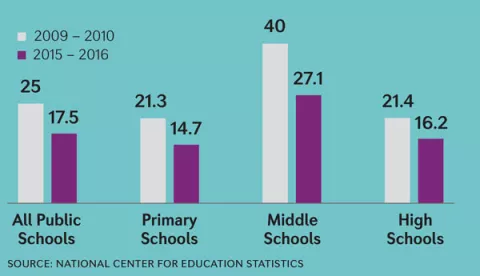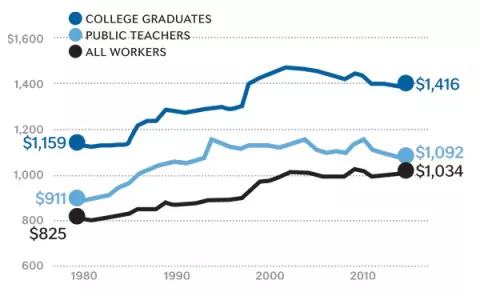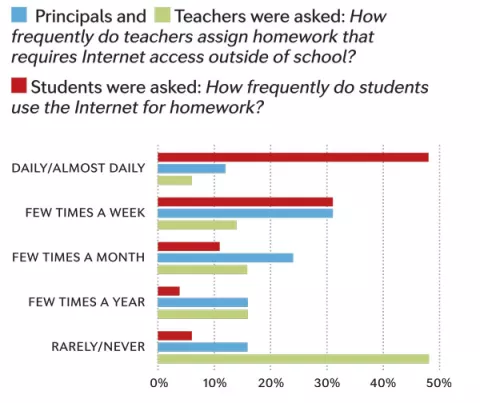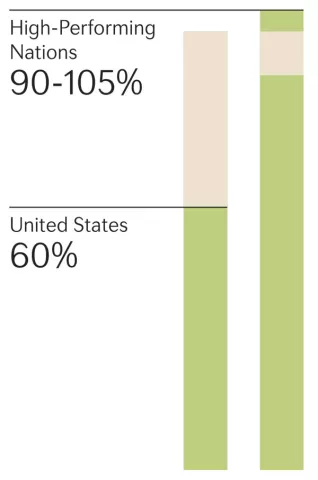Mandatory Retention Laws Fail Students
More states are adopting laws that require students to repeat the third grade if they don’t score at or above the proficient level.
According to the Education Commission of the States, 16 states plus Washington, D.C., have laws that require retention for students not reading at a certain level by the end of third grade. Unless exceptions are made, students most likely to suffer from these laws are students of color, students living in poverty, English language learners, and students with special needs.
Shyrelle Eubanks, a former Maryland teacher who is now a senior policy analyst for the National Education Association, says that retention alone does not ensure students will read proficiently after completing the third grade a second time.
“Retaining a student should always be the last resort and should not be determined by a single test score,” Eubanks says. “Other factors, such as the progress a student makes during the school year, input from teachers and parents, and the availability of student supports must be taken into account,” she adds.
NEA has long opposed the heavy emphasis placed on standardized bubble tests. Instead, the Association advocates for multiple measures that include authentic assessments linked to the standards, curricula, and the materials educators use. Schools should be equipped to provide nonacademic services to help address a student’s physical, social, and emotional health and well-being. Equity, adequacy, and sustainability in resources and quality among public schools and districts are other major elements to student success.
NEA advocates for successful retention prevention programs, such as classroom characteristics (individualized instruction and accelerated learning), community characteristics (parental and community support), and school characteristics (early warning systems and professional development). With a better system in place, educators can help reduce the need for punitive retention policies.
High Achieving, Low-Income Students Excluded From Gifted Classes
Are smart students from poor families more likely to be overlooked for gifted or high-level math classes? Yes, a team of North Carolina investigative journalists has found.
In June, led by reporter Joseph Neff, who is now a senior investigative journalist at the Marshall Project, the News & Observer in Raleigh, N.C., unveiled “Counted Out,” a three-part series that shows, convincingly, how high-achieving, low-income North Carolina students are often excluded from the classes that would challenge their abilities, help them attend college, and climb out of poverty, while equally achieving, wealthier students are counted in.
Using anonymized state records involving tens of thousands of students and zeroing in on end-of-grade achievement tests, Neff found that just one out of three low-income students with superior math scores was labeled gifted by educators, compared to one out of two students—with equal achievement—from wealthier homes. These high-potential, low-income students also were found much less likely to take high school math in middle school, “an important step toward the type of transcript that will open college doors,” notes Neff, with his colleagues Ann Doss Helms and David Raynor.
The journalists identified a “web of barriers” that work against low-income students, including some districts’ complicated measures of giftedness that favor students from English-speaking homes with high exposure to sophisticated language. They also found low-income parents who were less likely to ask the right questions, or know how to advocate for their children. The bottom line: “The unequal treatment during the six years ending in 2015 resulted in 9,000 low-income children in North Carolina being counted out of classes that could have opened a new academic world to them,” the journalists write.
Violence and Bullying Declines
Rate of violent incidents at public schools, per 1,000 students

Teacher Pay Penalty Driving Educators Out of the Profession
Educator salaries across all the professions have never truly recovered from the recession-driven hit they took in recent years, but a new study by the Economic Policy Institute (EPI) provides new insights—particularly on K–12 classroom teachers.
“Wages for teachers have been falling relative to comparable workers all over the country for many years,” says Lawrence Mishel, president of EPI. “Teachers were paid 2 percent less [than comparable workers] in 1994, but by 2015 the wage penalty rose to 17 percent.”
Mishel says people often counter that teachers get summers off, but the EPI wage penalty data looks at weekly wages rather than annual wages for a more accurate picture of what teachers make in comparison to comparable professions—accountants, for example —requiring the same level of education.
“Teachers do get more in health and pension benefits than other comparable workers, but they are seeing an erosion there, too,” says Mishel. “But even when you take into account that teachers have better benefits, that doesn’t outweigh the problem they have with lower wages. Teachers get about 27 percent of their compensation in benefits—the rest are wages and they remain low.”
The teacher pay penalty is a problem because it makes it hard for educators to maintain a middle-class standard of living, Mishel says. It matters for citizens and taxpayers because good schools attract business and revenue for communities, but it matters the most to children because ultimately low salaries drive away good teachers.
“We are moving into a world where fewer people are trying to enter teaching, in part because the profession has been degraded by misguided accountability measures and also because of the erosion of pay,” Mishel concludes.
Teachers’ weekly wages are 23 percent lower than those of other college graduates

Teachers and Students have Different Ideas on the Use of Tech After School
Students believe Internet access is more important to complete homework assignments than their teachers do. That’s according to a Speak Up Research Project for Digital Learning survey of students, educators, and parents. Nearly half of high school students say their teachers are assigning homework that requires technology, but only 10 percent of teachers say they do.
“Students, teachers, and administrators all have a different view on the role of Internet access outside of school,” the report states. “Few teachers say they regularly assign Internet-dependent homework. More principals think Internet-dependent homework is being assigned, but students say they regularly use the Internet to help with homework.”

Revoking DACA ‘Immoral and Un-American’
Upon taking office in January, President Donald Trump pledged to treat with “great heart” the 800,000 young people who are Deferred Action for Childhood Arrival (DACA) program recipients. On September 5, the administration abandoned that promise, announcing that it would be rescinding DACA.
“This decision is immoral and un-American,” NEA President Lily Eskelsen García said. “It will turn lives upside down and lead to unprecedented peril. After meeting all of the requirements to live and work in the United States, they will face deportation and separation from their families and our communities.”
The program, implemented in 2012 by the Obama administration, protects eligible youth from deportation for two years, subject to renewal, and provides them with a work authorization permit.
NEA believes DACA has been a resounding success, making the nation’s immigration policy more fair and more efficient, and brightening the futures of the nearly 800,000 aspiring young Americans who live, study, and work in the United States.
In July, Dick Durbin of Illinois and Lindsey Graham of South Carolina introduced bipartisan legislation, the Dream Act of 2017, that would grant legal status and a path to citizenship for undocumented immigrants who were brought to the country as children. NEA is urging Congress to act now.
“Now more than ever, we need a permanent legislative solution to DACA so these young people have the certainty they deserve,” said Eskelsen García. “Congress should not wait 6 months to permanently fix this decision but instead act immediately to protect DACA recipients and Dreamers, and pass into law the bipartisan Dream Act of 2017.”
The Secrets to Their Success
How do high-performing systems recruit, train, and retain a top-notch teacher workforce? Recently, Linda Darling-Hammond of Stanford University and a team of researchers undertook a groundbreaking, comprehensive study that examines how seven systems across four continents (New South Wales and Victoria in Australia, Alberta and Ontario in Canada, Finland, Shanghai, and Singapore) have succeeded on this front.
“Across the jurisdictions we studied, we saw an intentional effort to build systems that produce not just high achievement, but also equitable outcomes,” said Darling- Hammond. “These systems ensure that all teachers are well prepared and supported throughout their careers, that all students have access to great teaching and leaders, that the students most in need of excellent teachers get them, and that the schools that need the most funding and support to provide a high-quality education actually receive it.”
Each model is unique, but they share many similar approaches to reshaping and professionalizing teaching:
- Teacher salaries are competitive with those in other professions. In Singapore, for example, teachers are paid on par with civil engineers and accountants.
- Most or all the costs of preparation are covered by the government, and some actually pay a stipend to candidates.
- Extensive induction and apprenticeship is available for new teachers.
- Professional development and support is freely available throughout a teacher’s career.
- Schools in general are well-funded and equitable, so that teaching is well-supported.
The average teacher attrition rate in these high-performing systems is 3 or 4 percent—significantly lower than the 8 percent rate in the United States.
“If we could lower ours to 4 percent, we wouldn’t have any teacher shortages,” Darling-Hammond said.
As Darling-Hammond noted, there are “pockets of excellence” scattered across the United States, as a few states—namely, Connecticut and Massachusetts —have built up the teaching profession over time and have the student achievement to show for their efforts.
“States have taken this up,” Darling-Hammond said. “If we can keep politics out of it, we would be in a position to experience and reap the benefits of the good work that has already been sown.”

After the Hurricanes
Across the U.S., NEA members are helping educators and their families impacted by recent hurricanes. NEA and the American Federation of Teachers (AFT) jointly represent educators in Florida and they have combined fundraising efforts to assist members affected by Hurricane Irma. To donate, visit nea.org/hurricanerelief.
Out of concern for Caribbean students, public schools, and educators who were affected by Hurricane Irma, NEA has also contributed to Education International, which is working with the Caribbean Union of Teachers to help members in need.
Donations to the NEA Foundation’s Hurricane Harvey Relief Fund (visit nea.org, and search “Hurricane Sources and Relief”) and the AFT-NEA Irma Disaster Relief Fund.
] will help to absorb some of the expenses being faced by educators and their families. For more, visit nea.org/hurricanerelief.
“All of us can play a role in rebuilding the lives of those impacted by these natural disasters, standing strong for our members and their families, and mending communities,” said NEA President Lily Eskelsen García.

